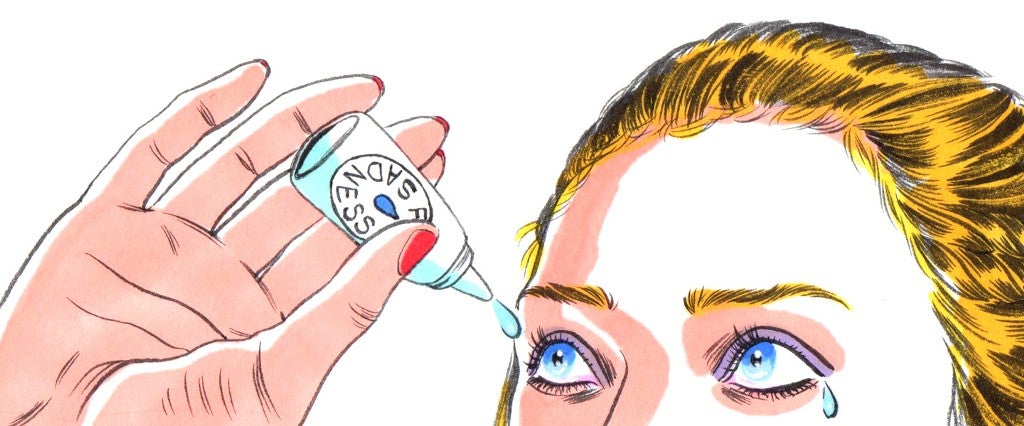Grief is a process. Everyone will tell you that. It takes time; it’s a daily slog. It’s work, it’s patience, it’s something to live — not something to get through. Everyone will tell you that.
But if movies have taught me anything about life, it’s that emotions are so big we can’t explain one with another. Joy isn’t happiness multiplied, it’s sunshine illuminating the dark corners of your brain. Love is a night sky filled with fireworks. Grief follows you, tainting everything in its path, those who see it on you treating you as though you’re suddenly made of glass, your brain irrevocably changed for the worse, the more unpredictable. Once the specter of tragedy has touched you, it’s inescapable. Those around you can see it even when you can’t anymore. The scent of something rotten stays on your skin long for others long after the sting has faded.
Grief can be a trap. Watching videos of soldiers coming home to their families, my eyes widen as they surprise their children at baseball games, pop out of Christmas wrapping, hug newborns they’re meeting for the first time at an airport — their boots still caked with dirt they’ve carried home with them from thousands of miles away. When one ends, YouTube offers me another, and another, until “God Bless America” is ringing in my ears and I’m adding “support our troops” bumper stickers to my Amazon cart. What I’m searching for, it seems, is not actually an endless supply of overjoyed puppies and children whose letters to Santa were answered; it’s sadness. And it’s just not in me.
As an adult, I’ve never been much of a cryer. I’m anxious, I’m frustrated, but sadness has never spoken to me much, despite my penchant for depressed white guys singing songs to their ex-girlfriends and books about the plight of the working poor. I’m not unemotional; I’m just not sad. Sadness is not a one-size-fits-all emotion. For some of us, it just doesn’t fit.
One of the most memorable moments in my adult life reminds me of how unusual this can seem to others. I was 20, standing barefoot in the kitchen of my childhood home with two of my closest friends. One was living in another country at the time, the other just blocks from where we stood. They had come over as a show of support during my mother’s three-month battle with cancer. As we stood there, drinking beer and catching up, one of my friends noticed the time. “Should we get to the hospital?” he asked, motioning to his watch. In a moment more uncomfortable than any I have experienced since, I calmly explained to them that she had died the previous day. I thought I’d mentioned it. The room fell silent.
Unemotional people tend to frighten others — and unemotional women even more so than their stoic male counterparts. When something sad happens and you don’t cry, it can make others deeply uncomfortable — often suspicious. Despite an overwhelming amount of evidence to the contrary, there are those who still believe Amanda Knox is a cold-blooded murderer because of the lack of emotion she showed during her trial and in the years since she was freed from prison. We critique qualified political candidates for their lack of warmth, as if they should be handing out cookies at debates to temper their preparedness. (Unfortunately, being open about your grief, crying, ripping down curtains and setting fire to effigies and wailing is no more socially acceptable.)
But emotionality is not a prerequisite for being a good or compassionate person, and the lack thereof doesn’t make you a monster. Outside of Meg Ryan’s oeuvre, love is rarely spurred by emotional outpouring, but rather a slow and steady trickle of facts and inside jokes and shared interests; hints at a person, not a flood of one. There is something to be said for those whose burdens don’t weigh heavily on the backs of others.
There are plenty of things to be sad about on a daily basis, but that shouldn’t leave you a sobbing wreck: the state of American politics, the gutting of the middle class, the fact that Arby’s is selling deer meat. A significant percentage of Americans are legitimately mourning what they imagine will mean a loss of their rights, their freedoms, their way of life as they know it while turning it into something actionable.
We once covered mirrors and donned veils to signify our mourning period; now, sadness has become an amorphous concept that scares the hell out of people. Do your grieving in private and at funerals. Make sure you’ve filled out the bereavement leave paperwork. Make sure you cry. Make sure you’re not too together, but don’t let it ruin your life. Don’t quit your day job. Don’t cry at the office. Don’t come back until you’re better. Don’t take too long.
At a bar with some new friends, someone asked me where my parents lived. I mentioned that they were dead. “Well, they’re always with you,” a woman offered.
They’re not. It’s okay when bad things that have happened to you don’t turn into a badge you wear in public. Trauma can exist and fade into anecdote. It can define you, but it doesn’t always have to.
Instead of expecting performative sadness, we need, more than ever, to understand its nuances. We need to accept it without demanding it. We need to embrace it without smothering it. And we need to stand beside it when it looks like action.
